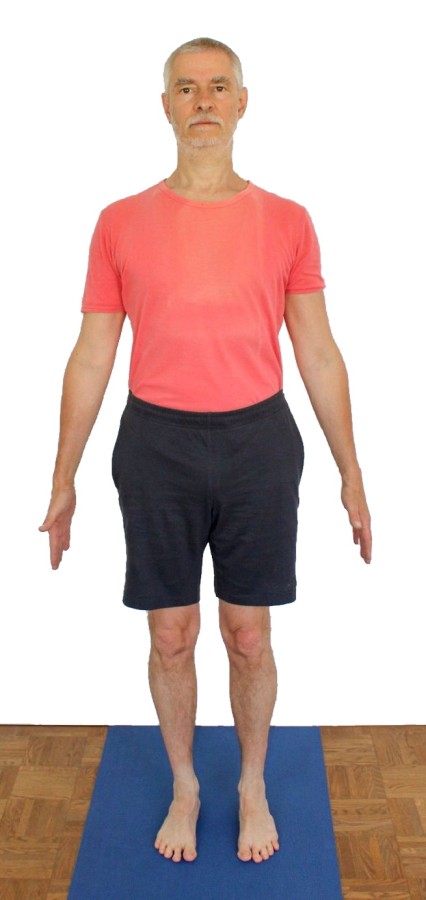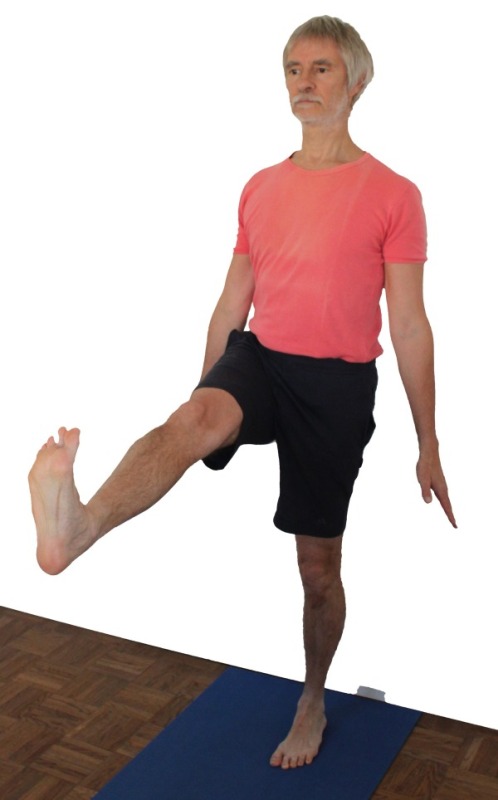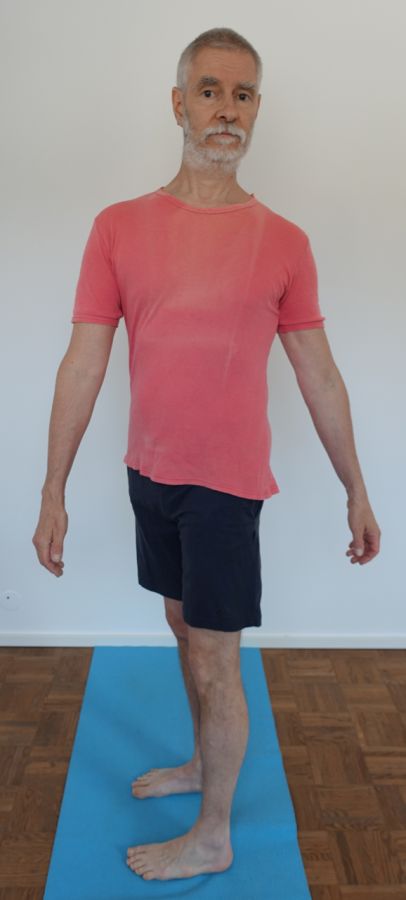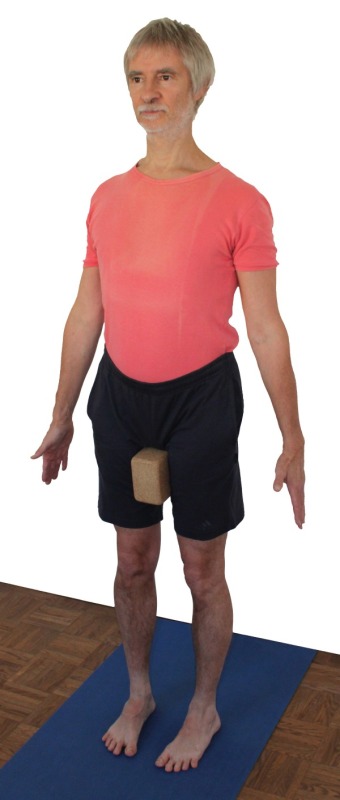Contents
tadasana
„Mountain“

 instructions and details with working links as PDF for download/print
instructions and details with working links as PDF for download/print
Feedback: We’d love to hear what you think about this description, give us feedback at:
postmeister@yogabook.org
last update: 12/30/2018
Name: tadasana
Trivial name: Mountain
Level: A
- Classification: A
- Contraindication
- effects
- Preparation
- follow-up
- derived asanas
- similar asanas
- diagnostics
- Instruction
- details
- Variants
Classification
classic: standing posture
Contraindication
Effects
Preparation
As tadasana is the anatomical „neutral zero„, i.e. the posture from which most joint movements (with the exception of the extension of the knee and elbow joints) should be possible in both directions of a given movement dimension and are described, no preparatory exercises are given apart from the stretching of shortened hip flexors, which is actually not uncommon and may make it impossible to assume neutral zero because the simultaneousness of a straightened pelvis and extended knee joint is impossible. Otherwise, all joints should be able to assume neutral zero, otherwise there would be extension deficits in the elbow joint or knee joint, for example. If, for example, the ankle joint were not able to assume neutral zero but remained in plantar flexion, the patient would have a pointed foot. Many other deformities can also be easily recognized in this posture. A hollow backcan be seen here, which is based on shortened hip flexors, so that the pelvis tilts forwards and downwards at the top. The following preliminary exercises are helpful in this case:
If the back is healthy, i.e. especially if there is no facet syndrome, spondylolisthesis, spinal canal stenosis or lumbago, the following are also possible:
and other backbends with extension in the hip joint.
Follow-up
derived asanas:
urdhva hastasana free backbend
similar asanas:
Diagnostics (No.)
In tadasana, due to the extended legs and the upwardly stretched torso, a hollow back tiltbased on a shortening of the hip flexors can be easily recognized if, despite intensive work of the extensors of the hip joint (the hamstrings and, if more strength is required, especially the gluteus maximus), an upright pelvis cannot be produced.
(880) Hyperextension of the knee joints
Overextension of the knee joint refers to the ability to or the current state of an angle of more than 180° in the knee joint. To a certain extent, this is considered normal by anatomists and is on average more common and more pronounced in females. However, it can also indicate weakness of the quadriceps or hamstrings. Furthermore, hyperextension often causes unphysiological sensations that are not caused by stretching or straining the muscles and should be avoided, see also the FAQ. In addition to hyperextension of the knee joint, an extension deficit of the knee joint would also be visible here; this can be congenital or acquired, e.g. due to a shortening of the caput breve of the biceps femoris.
(650) Kyphosis and lordosis of the spine
The deviations from the physiological double-S shape of the human spine are clearly visible in this posture. There should be a certain degree of lordosis (convex spine from the front) in the lumbar and cervical spine and a certain degree of kyphosis (convex spine from the back) in the thoracic spine. See the FAQScoliosis
(611) Pelvic obliquity/unequalshoulder height/scoliosis of the spine
The lateral deviations of the spine from the median plane known as scolioses are also quite visible in this posture. See the FAQ.
(950) Foot deformities:
In particular, fallen arches and flat feet become quite visible in tadasana. A hindfoot valgus is shown by the Achilles tendon running inwards from the heel bone. A pointed foot makes it difficult or impossible to stand (even) on the heel. Hallux valgus is also clearly visible. These deformities should be clarified by a specialist so that they cause no or only minimal damage to the rest of the musculoskeletal system. Metatarsalgia can occur in the form of pain on the ball of the foot, while a plantar heel spur is characterized by a stabbing pain on the front of the heel bone.
An extension deficit or hyperextensibilityand hyperextensionin the elbow can also be seen here. As with the knee joint, it can be congenital or acquired. An extension deficit can, for example, be the result of heavy physical work or non-full-range muscle training (i.e. with reduced ROM).
(696) Thorax:
Thoracic deformities of various kinds may be seen here. These can also be congenital or acquired.(884) Knee joint
In the case of damage to the knee joint, pain can occur even in this position under the load of a large partial body weight, indicating damage.
In the case of damage to the hip joints, pain can occur even in this posture under the load of a large partial body weight, indicating damage.
Variants:
Instructions
- The hip-width version is described here, but there is also a version with closed feet. Stand up straight with your feet hip-width apart.
- Place your feet so that the midlines of your feet are parallel.
- Spread your toes as wide as possible so that they are evenly fanned out and as far apart from each other as possible on the floor with the toenails pointing upwards.
- Place weight on the inner foot, i.e. the metatarsophalangeal joint, so that it bears as much weight as the outer foot.
- Extend the knee joints from a little tension in the quadriceps muscles.
- Do not turn the thighs out but stretch the inner knee backwards just as forcefully as the outer knee.
- Move the pelvis backwards as far as possible without tilting it forwards (into flexion)
- If there is a slight flexion in the hip joints, counteract this by using the hamstrings or (if more strength is required) the gluteal muscles until the pelvis is exactly vertical.
- Stretch the front and back of the body evenly upwards from the pelvis.
- Stretch the head upwards so that the crown of the head is the highest point.
- Move the arms a little sideways away from the body, turn the upper arms out as far as possible, turn the forearms back in (into pronation) so that the palms are facing inwards (towards the pelvis) and lower the arms from the side back towards the upper body.
- Move the shoulder blades backwards and inwards, keeping them pulled down with a little activity.
Details
- Tadasana can be practiced with both hip-width and closed feet. The version with feet hip-width apart is easier because it is more stable and also accommodates the supination tendencyof the foot, while a closed stance means minimal pronation and is not far from the limit of flexibility for many people.
- If spreading the toes causes difficulties, proceed as follows:
- Lift the front foot (from the heels: ball of the foot and toes) off the ground.
- Turn the leg (and therefore the foot) on the heel approx. 20° outwards.
- Tilt the foot into supination (outer edge towards the floor) until the outer edge presses against the floor.
- Press the little toe onto the floor.
- Turn the thigh back in and tilt the foot down again with its inner edge until the foot is fully parallel to the floor again. The friction of the little toe on the floor spreads it out laterally as much as possible so that ideally its nail is pointing upwards and the other toes are well spread out on the floor up to the big toe.
- Overextending the knee joint is a difficulty that can occur in many postures and should be addressed in particular in those postures in which, according to the structure of the exercise, greater torques can occur in the knee joint in the direction of overextension. Although there is no particular need to intervene against overstretching in tadasana in this respect, tadasana is considered THE cardinal standing posture in which many basic principles are taught and practiced, which is why this detail naturally also deserves special attention. A first attempt to reduce hyperextension can be made by twisting the thighs in before hyperextension occurs. It is far more effective, but also more difficult and more strenuous, to tense the front and back of the thighs and allow them to work against each other so that a dynamic balance of forces can be established in the knee joint through conscious use and controlled effort, allowing the angle in the knee joint to be freely determined, see the corresponding exploration. Overstretching can cause discomfort in both the dorsal and ventral knee joint area, the former possibly due to overstretching of the capsule, the latter due to compression of the bones and soft tissue; in either case, these are not beneficial but potentially damaging processes, which is why overstretching should be avoided at all costs, at the latest if it is subjectively perceived as unpleasant, and preferably as a matter of principle. In many forward bends, there is an easy-to-perform trick that regularly works well if the flexibility of the hamstrings is not yet very well developed: with the knee joint clearly bent, the flank or abdomen (depending on the posture) is pressed onto the thigh and held pressed, while as the knee joint is extended further, the sensation of stretching gradually increases, so that overstretching is reliably prevented.
- The posture requires constant, moderate use of the hamstrings if the hip flexors are mobile or also of the gluteus maximus if the hip flexors are clearly restricted in their flexibility so that the pelvis does not tilt into flexion, especially when moving backwards.
- The use of the gluteus maximus tends to turn the legs out. Counteract this by using the endorotatory adductors (i.e. the adductor magnus). The use of the gluteus maxim us can also cause flexion in the knee joint, which is likely if the hip flexors have limited flexibility. Continuous adequate use of the quadriceps is then required to keep the knee joint extended. This effect is not based on the gluteus maximus pulling the thighs forward (this is not one of its functions), but on the gluteus maximus straightening the pelvis and pulling the thigh forward at its attachment to the lesser trochanter via the resulting increased traction of the shortened hip flexors, especially the iliopsoas.
- As described above, constant use of the quadriceps is required to prevent the knee joint from bending, especially if the hip flexors are restricted in their flexibility and the gluteus maximus has to be used to straighten the pelvis as a result.
- The last three points show that (depending on flexibility) three sides of the thigh muscles are constantly working:
- the inner side(adductors): to neutralize the tendency to turn the legs out.
- the back (hamstrings): to help straighten the pelvis.
- the front(quadriceps): to neutralize the tendency to bend the knee joints, which is similar to the situation in shoulderstand, except that the adductors also have to compensate for the tendency of the thighs to move outwards into abduction in the hip joints, which is possible because, unlike in tadasana, the leg in shoulderstand is not a standing leg but a free leg. Although this necessity is seemingly completely eliminated in tadasana due to the feet being fixed to the floor, the abducting moments generated by the gluteus maximus (and other dorsal hip muscles) cause an increased supination tendencyin the ankles.
- The pelvis should be as far back as possible in tadasana. If it is moved backwards, the front feet (balls of the feet) become lighter. Nevertheless, try to exert pressure on the floor there. If the pelvis is moved backwards, the tendency to tilt into flexion in the hip joints increases. Counteract this. The optimum position of the pelvis is reached when you are perhaps subjectively on the verge of falling backwards, but can still press the balls of your feet onto the floor.
- In tadasana, both the front and back of the upper body should be stretched upwards. Excessive use of one or the other leads to excessive strain in the back muscles and lower rib bones protruding forwards and upwards or an excessively round back. Often the shoulder blades are also pulled up ( elevated to some extent) when the upper body is stretched. Consciously move them backwards and inwards in retraction and depression.
- The gluteal muscles are used to straighten the pelvis in a vertical, i.e. longitudinal direction, not in a horizontal or transverse direction, i.e. the movement of the buttocks and the rear part of the iliac crest towards the hamstrings in the back of the thigh is not meant.
- The hip flexor flexibility test usually provides useful information on whether it is possible or impossible to straighten the pelvis with the knee joint extended, even if it typically indicates the flexibility of the rectus femoris.
- The head stretches vertically upwards. Conspicuous features here can be a forward posture that has become habitual during daily sitting, a tendency to let the head sink slowly forwards or into the neck. A steep posture or hyperlordosis of the cervical spine can also be clearly seen here.
- Quite a few people have a tendency to tilt their head to one side because they perceive this as being straight. This is a manifestation of a very common and easily understandable phenomenon: without external aids such as mirrors or supporters, people align themselves according to their proprioception, i.e. according to the muscle tension they feel, among other things. If one side is less flexible than the other, they must inevitably feel straight in a certain tilted position. If he is then corrected so that he is objectively straight, he must feel odd because his proprioception reports a side difference. See the FAQ.
Variants
eka pada prasarita

Effects: (817) Strengthening the rectus femoris
(842) Strengthening the foot lifts
(711) Stretching the hip flexors
Instructions
- Assume tadasana as described above.
- Shift your body weight onto one foot.
- Raise the unloaded leg stretched to the maximum forward and upward.
Details
- In contrast to the basic pose, this pose has a clear balancing character. Shifting the weight and lifting the unloaded leg off the floor must be done carefully and slowly.
- Lifting the leg is usually limited by the restricted flexibility of the hamstrings. Only rarely is the strength of the hip flexors insufficient to lift the leg significantly at all. If they are strong enough, the leg can be lifted so strongly (not: far!) that a stretching sensation occurs in the back of the leg; this effect allows a statement to be made about the strength of the hip flexors. If the hip flexors are not particularly strong, there will be no stretching sensation, rather the rectus femoris will begin to cramp, as it is already working at a very short sarcomere length and therefore close to passive and active insufficiency.
- When the leg is lifted far, the hip extensors (especially the hamstrings) pull on the pelvis to tilt it backwards. If the hip flexors are not flexible enough to hold the pelvis upright effortlessly in the basic posture of tadasana, the pull of the hip flexors will cause the knee joint of the standing leg to bend even more when the leg is raised further. This must, of course, be countered by using more quadriceps strength. This will also lead to increased tone of the rectus femoris (as part of the quadriceps) and increase the tendency to spasm, even if the need for muscular work relates to the contralateral side. However, the rectus femoris, which has to work intensively in the lifted leg, cannot regenerate well after changing sides in the standing leg. Therefore, extension-promotinghip openings are very useful as preparation for this posture in addition to all the preparatory postures that promote the flexibility of the hamstrings so that the leg can be lifted more easily and further. Of course, the development of a cramp must be avoided. If a tendency to cramp occurs, the lifted leg can be lowered a few centimetres or bent a little at the knee joint to avoid the cramp.
- As the hip joint can move in three dimensions, further evasive movements will occur, in particular the pelvis will want to lift on the side of the lifted leg, which should of course be avoided. In addition, the lifted leg will often tend to turn out. How strong this tendency is depends not least on the ratio of the flexibility of the muscles in the inner and outer hamstrings. However, the tendency to exorotate is also due to the position of the insertion of the iliopsoas on the femur.
- As in vrksasana, it is also important to observe the typical aspects of balancing postures on one leg, see there.
- Sometimes the upper body is tilted backwards in order to lift the leg further without having to increase the tone, i.e. the effort of the hip flexors. This is of course undesirable for several reasons. Firstly, it leads to a hollow back, which can be particularly unpleasant on the side of the standing leg. Secondly, this increases the bending angle of the knee joint of the standing leg without any increased benefit.
- When the leg is lifted, the pelvis will tend to tilt forward due to the pull of the iliopsoas on the iliac crest and the lumbar spine. Try to compensate for this as much as possible.
Known problems that can occur even when performed correctly
Tendency to cramp in the rectus femoris
Lifting the straight leg can cause a significant tendency to cramp in the rectus femoris of the lifted leg, see above. This is all the more pronounced the more intensively and the longer the leg is lifted.
parivrtta

Instructions
- Assume tadasana as described above.
- With the legs exactly straight and the hips exactly extended, turn the body to one side as far as possible and then to the other.
Details
- The twist should not bend the knee or hip joints. Rotational moments are simply not good for the knee joints, especially if they are already damaged, and the rotation of the knee joints has no positive influence on the goal of the posture. In the case of the hip joints, flexion would clearly run counter to the aim of the posture. The psoas major has a hip-bending effect due to the rotation – which is clearly noticeable for most people who perform this posture – because the area of origin at the lumbar spine is pulled away from the attachment to the lesser trochanter. On the other hand, if the hip joint is held extended, this variation has a slightly stretching effect on the psoas major. The strength of this muscle and which rotatory muscles are suitable for producing a stretching effect must be taken into account for assessment. Irrespective of this, this posture has a stretching or strengthening effect on all hip rotator muscles, starting with the endorotatory adductor magnus through the rotator muscles of the pelvitrochanteric musculature to parts of the autochthonous back musculature and the oblique abdominal musculature. One leg rotates in and the other out at the same time, so when rotating to the right, the left hip joint performs an exorotation and the right an endorotation. This creates a harmonious and harmonizing effect on many muscles, which has both a stretching and strengthening effect. This variant is recommended for muscular disorders such as lumbago, because it must be assumed that more profound parts of the autochthonous back muscles are affected by the spasmodic hypertonicity, which also have a rotatory function (albeit of secondary importance).
salamba parivrtta
Instruction
- Take the parivrtta variation of tadasana as described above.
- Take the hand of the side you are twisting towards, bring the arm behind the back and press the back of the hand against the contralateral side of the pelvis to strengthen the twist.
Details
- Pressing the back of the hand against the contralateral side of the pelvis allows the upper body to rotate more intensely, pushing the shoulder blade into wide retraction and stretching the deltoid pars clavicularis. Due to the more intensive rotation of the trunk, the tendency of the hip joints to flex is also increased, which must be compensated for with the strength of the hip extensors.
with block

More control over the movement of the thighs (not turning out).
Instructions
- Assume tadasana with a block between the thighs, approximately in the middle of the thighs.
- Turn the thighs in to move the block backwards, but avoid making the pelvis less upright.
Details
- The block between the legs serves to consciously counteract the tendency of the thighs to turn out at the same time as the pelvis straightens due to the force of the gluteus maximus. Learn to consciously rotate the thighs in and out alternately and observe the result in the movement of the block, which must move backwards when the thighs are rotated in.
- This use of the block can be found in other postures, e.g. headstand, handstand, shoulderstand.
- In most cases, the block between the thighs and the maximum tolerable pressure that it exerts define a minimum distance between the feet.
